#Polystyrene Price
Text
Polystyrene Prices | Pricing | Trend | News | Database | Chart | Forecast
Polystyrene prices have been a significant topic of interest for industries and businesses that rely heavily on this versatile material. Polystyrene, a polymer made from the monomer styrene, is used in various applications, from packaging and insulation to disposable food containers and electronics. The prices of polystyrene are influenced by several factors, including raw material costs, production capacities, demand fluctuations, and broader economic conditions. Understanding the dynamics behind polystyrene pricing is essential for manufacturers and consumers alike, as it directly affects production costs and, ultimately, consumer prices.
One of the primary factors driving polystyrene prices is the cost of raw materials. Polystyrene is derived from styrene, which, in turn, is a byproduct of petroleum refining. As a result, the price of crude oil has a direct impact on the cost of producing styrene and, by extension, polystyrene. When oil prices rise, the cost of styrene tends to increase, pushing up polystyrene prices. Conversely, when oil prices fall, the cost of producing polystyrene decreases, which may lead to lower prices. However, the relationship between oil prices and polystyrene is not always linear, as other factors, such as supply chain disruptions or geopolitical tensions, can also play a role in determining polystyrene prices.
Get Real Time Prices for Polystyrene: https://www.chemanalyst.com/Pricing-data/polystyrene-ps-11
Another significant factor influencing polystyrene prices is global production capacity. Polystyrene production is concentrated in several key regions, including North America, Europe, and Asia. Changes in production capacity, whether due to plant shutdowns, expansions, or new plant developments, can have a direct impact on polystyrene supply. For instance, if a major production facility experiences an unexpected shutdown, the reduced supply can lead to a spike in prices. On the other hand, an increase in production capacity, such as the commissioning of new plants, can lead to an oversupply in the market, putting downward pressure on prices.
Demand fluctuations also play a crucial role in determining polystyrene prices. Polystyrene is widely used in industries such as packaging, construction, automotive, and electronics. Changes in demand from these sectors can significantly influence pricing. For example, during periods of strong economic growth, demand for polystyrene-based products, such as packaging materials for consumer goods, tends to increase. This rise in demand can push up prices, especially if supply is unable to keep pace. Conversely, during economic downturns, demand for polystyrene products may decline, leading to lower prices. Additionally, seasonal factors can influence demand, particularly in sectors like construction, where demand for insulation materials often peaks during certain times of the year.
The global supply chain also has a considerable impact on polystyrene prices. In recent years, supply chain disruptions have become more frequent due to various factors, including natural disasters, logistical challenges, and global pandemics. These disruptions can lead to delays in the delivery of raw materials and finished products, which in turn affects pricing. For instance, if there are delays in the transportation of styrene to polystyrene production facilities, manufacturers may face higher costs, which are then passed on to consumers in the form of higher prices. Similarly, disruptions in the availability of transportation or shipping routes can lead to increased costs and delays in delivering polystyrene to end-users, further affecting prices.
Another critical factor that affects polystyrene prices is environmental regulations and sustainability concerns. In recent years, there has been growing awareness of the environmental impact of plastic waste, leading to increased regulatory scrutiny on the production and disposal of plastics, including polystyrene. Some countries have implemented stricter regulations on the use of single-use plastics, which has affected demand for polystyrene in certain applications, such as disposable food containers. At the same time, there is increasing pressure on manufacturers to develop more sustainable alternatives to traditional polystyrene, such as biodegradable plastics or recycled polystyrene. These regulatory and market pressures can lead to shifts in demand and supply, influencing prices.
The impact of currency exchange rates should also be considered when analyzing polystyrene prices, especially in the context of international trade. Polystyrene is traded globally, and fluctuations in currency exchange rates can affect the competitiveness of exports and imports. For example, if the value of a currency strengthens relative to other currencies, polystyrene producers in that country may find it more difficult to compete in international markets, leading to lower demand and potentially lower prices. Conversely, a weaker currency can make exports more attractive, boosting demand and pushing up prices. Currency fluctuations can also affect the cost of importing raw materials, such as styrene, further influencing the overall price of polystyrene.
Economic factors, such as inflation and interest rates, can also have an indirect impact on polystyrene prices. Inflationary pressures, particularly in key producer countries, can lead to increased production costs, including higher wages, energy prices, and transportation costs. These cost increases are often passed on to consumers in the form of higher prices for polystyrene. Similarly, changes in interest rates can affect the cost of borrowing for businesses, which may influence their investment decisions, such as expanding production capacity or upgrading facilities. Higher interest rates can increase the cost of financing these projects, potentially leading to higher prices for polystyrene if supply is constrained.
In conclusion, polystyrene prices are shaped by a complex interplay of factors, including raw material costs, production capacity, demand fluctuations, supply chain dynamics, environmental regulations, currency exchange rates, and broader economic conditions. Businesses that rely on polystyrene need to stay informed about these factors to effectively manage costs and ensure competitiveness in the market. As global markets continue to evolve, polystyrene prices will likely remain subject to volatility, requiring careful attention to trends and developments in the industry.
Get Real Time Prices for Polystyrene: https://www.chemanalyst.com/Pricing-data/polystyrene-ps-11
Contact Us:
ChemAnalyst
GmbH - S-01, 2.floor, Subbelrather Straße,
15a Cologne, 50823, Germany
Call: +49-221-6505-8833
Email: [email protected]
Website: https://www.chemanalyst.com
#Polystyrene#Polystyrene Price#Polystyrene Prices#Polystyrene Pricing#Polystyrene News#Polystyrene Price Monitor#Polystyrene Database
0 notes
Text
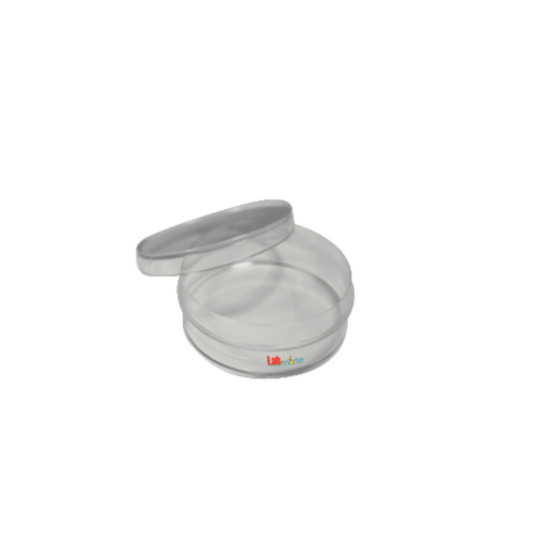
Labmate Polystyrene Petri Dish is a small, round dish used for growing and observing microorganisms, cells, or small plant tissues. It has a culture area of 8.65 cm² and measures 35 mm in diameter and 9 mm in height. The dish is pre-sterilized to prevent contamination and comes with a unique code for easy identification. Its design includes a serrated edge for a secure grip and leak prevention, as well as a vent for controlled air exchange. Made of clear polystyrene, the dish allows easy observation of its contents and requires minimal maintenance, with simple cleaning.
2 notes
·
View notes
Text

Toho, in conjunction with Bottleneck Gallery, has released a Godzilla Minus One lenticular print. The 24x36 poster is printed on 4mm polystyrene and comes with a certificate of authenticity. Priced at $200, it's up for pre-order through March 24 and is expected to ship in June.
#godzilla minus one#godzilla#godzilla minus 1#gojira mainasu wan#gojira#toho#toho studios#bottleneck gallery#art#gift#takashi yamazaki#kiyoko shibuya#ryunosuke kamiki#kaiju#daikaiju
147 notes
·
View notes
Note
Leo Hulseman, a former employee of the Dixie Co. in the 1930s, created the "Solo Cup", a paper cone he made at his home and sold to bottled-water companies. Later the company developed other products, like wax-coated cups and the plastic Cozy Cup. The wax-coated cups were added to its lineup in the 1950s, as fountain sodas gained popularity.[citation needed]
Leo Hulseman founded the Solo Cup Company in 1936, The company was originally incorporated in 1955 under the name Hulseman Paper Corporation.
In the 1970s, Hulseman's son, Robert Leo Hulseman, came up with the now-ubiquitous (in the United States), red Solo cup. The red Solo cups are made of thick, molded polystyrene. They are known for being able to withstand drops, easily stackable, and disposable while price accessible. Their characteristic red color may conceal the drinking contents.[5]
On June 30, 1980, SOLCO, Inc. and RM LEASING CORPORATION merged into Solo Cup Company.
On March 1, 2004, Solo acquired Sweetheart Cup Company for $917.2 million, in part with public debt. Sweetheart was founded by Joseph Shapiro and his four brothers, emigrants from Russia. It became the largest consumer packaging company in the world and was sold several times before being acquired by Solo Cup. Following the acquisition, Solo Cup's finances suffered, and Standard & Poor's lowered their credit rating from B to CCC+.[6]In late 2006, Solo Cup was reported to be $1.1 billion in debt.[7]
In 2005, the Museum of Modern Art in New York City added a Solo Cup Traveler's Lid to its permanent collection.[8][9][10][11][12] The lid was featured because it symbolized innovation and progress in basic product design.[13][11][14][15]
Solo Cup Company closed its longstanding facility in Highland Park, Illinois, in December 2009 and relocated to Lake Forest, Illinois.
On May 4, 2012, Solo Cup Company was acquired by Dart Container.
fascinating
17 notes
·
View notes
Text
I need to resist the urge to put the League of Villains and families/heroes on a typical old Latam children's birthday party bUT :
I can picture Endeavor swearing that if Midoriya strikes down that piñata instead of Shouto he's disowning everyone and leaving the party. He's the dad that takes the team to judge the stance of his kids whenever it's their time to swing at the piñata and if the stance. He screams the whole time. It's not a final baseball game, sir. Chill out.
Deku has a ball pit confrontation with Bakugo and now they're sporting a matching pair of black eyes. Something about the speed at which they throw those plastic balls at each other.
Mic is leading the most intense game of enano y gigante (if they say giant you stand up and if they say dwarf you duck, but the host says something and does something else to confuse you and if you do get confused, you're out of the game). The price is probably some plastic toy, but people are cheering like the Olympics. It's class 1-A against class 1-B.
I BEG to have Aizawa handling the piñata. Even if that place is often reserved to the dysfunctional uncle of the family, I think he would make at least one kid cry over pulling the piñata up when the kid swings to strike it.
There's a group of pre-teens playing with their DSs in the corner (Tomura and Spinner are there). The adults are doing karaoke (Midnight wants to form teams and compete for extra booze). Some kid (Mustard probably) refuses to get out of the slide and the slide traffic is about to explode in a kids fight (Kota will try to punch him).
There's at least one concussion when the piñata finally breaks and all hell made of candy rains over children diving to claim their bounty and fill their plastic bags. Toga cuts someone else's bags and starts stealing their candy. There's one kid with a giant black plastic bag, the ones they use for the big ass trash cans. There's a mother screaming at another mother over her kid behavior (family beef family beef family beef).
Half the prices for the party games are dolls that can be genuinely cursed, if the parents have an opinion on the matter. The other half are cheap imitations of Stain or All Might action figures, the type that end up called Spot and All Strength.
And if it's Momo's birthday party, there is at least one of those fake castle entrances made out of expanded polystyrene and a box where kids leave their gifts upon entering and the party favors are full of the expensive type of candy.
It's glorious, it's messy, they'll never forget it.
6 notes
·
View notes
Text

Fierce Husbands
Yesterday's sad Rainy Night Wen was having a tough time of it. But today we're jumping ahead to Episode 16, where we have our two favorites reuniting (again).
I absolutely love this scene. It's incredible.
I remember watching this for the first time and being utterly blown away by how Lao Wen just swoops down and it's like the previous scenes never happened, he's so intent on ensuring A-Xu is alright. And the look on Zhou Zishu's face. That breath Zhang Zhehan takes in is just incredible. They're both so badass and the scene is just tender and gorgeously romantic at the same time.
So of course these two figs are a must have.
That being said, they were definitely not something I could have, at least when they were first produced. The fig maker restricted the sales of this set and two other sets in the same series with some pretty onerous restrictions. In order to purchase these, you had to show proof of endorsement purchases / charitable donations for both actors, provide screenshots of your social media accounts to prove you were a CP fan, and had to have bought at least 6 previous figures from their shop before. I could have done the first two, but the last I had not. At the time these were launched, I had not had the opportunity at that point to buy directly from their shop for more than just a few figs.
So, I resigned myself to tracking these down on the secondary resale market once they were produced and shipped. I figured they'd cost a pretty premium when marked up for their rarity and popularity, but I searched and searched (and searched some more), and luckily didn't end up paying all that much more over original price.

These two arrived in their protective polystyrene cases, but somewhere in the travels home to me, they met with misfortune.

Ahh! Horrible. The stuff of figthusiast nightmares. I yelped when his little head rolled right out of the box.
Luckily, the break was pretty clean. Sometimes, like in this case, the break is the least of all possible problems. What's much worse is chipped paint and / or collateral damage that is caused when the broken pieces bang and scrape against each other. Some super gentle buffing with a Magic Eraser can sometimes help with discolorations. Chipped paint, though, is a whole other story. Speaking of which...

Lao Wen did not escape unscathed either. His poor hairpin! If you read yesterday's post, you saw where the fig maker sent his hairpin separately. It's to prevent exactly this. Now I've had lots of figs with pre-attached hairpins make it to me OK, but certainly not all of them.
If you look closely, you can see where the paint has broken off. There's no mending this one perfectly with this much damage, unfortunately.

Here's Baiyi, and you can see his hand where he can hold the hilt. Thankfully, the sword fit perfectly into his hand. You can also see here that A-Xu's beautiful neck is as good as new, more or less.

You can see here how well A-Xu holds his sword - really nice modeling on the hand. It's snug enough of a fit it won't fall out, but not too tight that I worry about damaging his little fingers.

What a cute angle for these two! I love the flowy motion of their robes as they both head towards each other.

Ah the epic image. I know A-Xu looks a bit taller here, but his high ponytail and weimao are adding some extra volume to his head!

Sadly, this is a good angle to see the damage in the mended hairpin. After the success I had with painting over the damage to Lao Wen's xiao in yesterday's fig, I'm going to mix up some paint and try to do the same for this hairpin.

Oof, this is an even better angle to see the damage in the poor hairpin. I had a hard time getting it to even stick together, as you can see. In happier news, their robes look fantastic here, and Baiyi also looks great. It's well sized for the fig and adds interest while not distracting from the overall scene.

I really love the movement in their robes and their hair.

The modeling on these figs is very true to the show, I've been watching my little clip on a loop and I'm impressed with the fig maker's level of detail.

The little one-sided wrinkle by Lao Wen's left eye just delights me!

And we're back around. Look at how each of them has a foot stepping out front as they walk to each other. I just love them.

Despite the dynamic poses, these figs stand quite well. Normally robe layers like this help to balance the figs, but these figs are a little unusual in that so much of their robes are flowing off the ground.
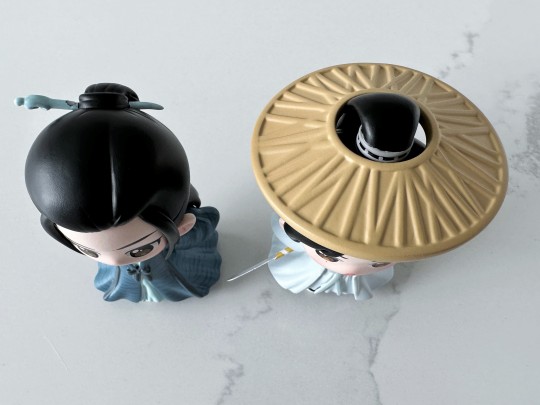
This show made me fall in love with the weimao. It's such a great look.

I'll come back and post a pic of the painted hairpin when I attempt it. Hopefully this weekend!

These figs came in a plain white box, so no box art, but the box card art is lovely!
The other two sets are just getting stocked in at my warehouse, so it'll probably be a month before they arrive at home. They'll skip to the front of the posting line when they do, though!
Material: Resin
Fig Count: 389
Scene Count: 26
Rating: Fierce and loyal!
[link back to Master Fig Index for more posts]
#wenzhou#word of honor#word of honor merch#episode 16#gong jun#zhang zhehan#junzhe#figthusiast#a-xu#lao wen
8 notes
·
View notes
Text
What does a surfboard cost?
The cost of a surfboard can vary widely depending on a number of factors, including the materials used to make the board, the brand, and the level of customization.
At the lower end of the spectrum, you can find foam surfboards that are typically made of polystyrene foam and coated with a layer of fiberglass. These boards can cost as little as $300-$500 and are a good option for beginners or those on a budget. They are also relatively durable and easy to repair if they get damaged.
Mid-range surfboards, which are often made of more expensive materials such as epoxy or polyurethane, can cost anywhere from $500-$1000. These boards are typically more lightweight and offer improved performance over foam boards. They are also more resistant to dings and damage.
High-end surfboards, which are made from advanced materials like carbon fiber or foam-epoxy composites, can cost upwards of $1000 or even more. These boards are designed for experienced surfers or professionals who require a higher level of performance and durability. Some custom-shaped surfboards can go even over $3000.

In addition to the cost of the board itself, you may also need to budget for additional expenses such as fins, leashes, and surf wax. If you're just starting out, it's generally a good idea to buy a used surfboard or rent one to see if the sport is something you'll continue to enjoy before making a bigger investment.
You also have to think about accessories like fins, traction pads, bags, and board covers, which are essential to keeping the board in good condition.
It's worth noting that the cost of a surfboard will also vary depending on where you live and the availability of surf shops and retailers in your area. If you're looking for a high-end surfboard, it may be necessary to shop online or travel to find the right board at the right price.
Overall, the cost of a surfboard can range widely depending on the type and quality of board you're looking for. Beginners can usually get started with a basic foam board for around $300 to $500, while more experienced surfers may want to invest in a more advanced board that costs $1000 or more.
Looking for a surfboard cover? For your beautiful surfboard, Surfboard Soks has the world's largest range of surfboard covers. trusted by the world's best surfers. Check out the longboard and shortboard covers at Surfboard Soks.

A surfboard is a watercraft used in the sport of surfing. It typically consists of a long, narrow board made of foam or other lightweight materials, with one or more fins attached to the bottom to help the rider maintain control and direction while riding a wave.
Surfboard design is also a matter of personal preference. Some surfers prefer a more traditional design, while others prefer a more modern, high-performance design. The shape, rocker, and fins can be adjusted to match the surfer's riding style, as well as the wave conditions.

In conclusion, a surfboard is an essential tool for surfing, the right one can make all the difference in your experience, it can be fun and challenging, but also with a lot of options to choose from that can suit your needs and preferences.
10 notes
·
View notes
Text
Gautier reuses trees blackened by summer fires

The Vendée-based furniture manufacturer Gautier buys back the burnt trees that it incorporates into its wooden panels at the same price. This is one of the components of Gautier's very technical CSR plan, which also aims to use recycled wood, vegetable glues and a reduction in packaging.
The pines damaged by the summer fires, in Landiras, in the Gironde department close to Bordeaux, or in Beaugé, in the Maine-et-Loire department, are not lost for everyone. Gautier, a furniture manufacturer in the Vendée department[1], decided to integrate them into the manufacture of its panels. "If the bark is burnt, the heart of the logs is still green," explains David Soulard, general manager of the company, that buys the trunks at the same price as its usual wood. "It's also a way to support the wood industry," he says. “And after a fire, the sooner the charred trees are felled, the sooner the forest will grow back. »
Gautier[2] has a debarking drum on its Chantonnay[3] site to remove the blackened part, that can be used as biomass or mulch. "If the heart of the burnt trunk has kept its properties, it must be used more quickly because it does not remain," explains Pierre Grolleau, head of panel activity at Gautier.
Towards 100% recycled
This reuse of burnt wood is part of a broader CSR plan[4] with a high technical content. First and foremost, Gautier wants to go from 50% to 100% recycled wood over the next five years. The company, that works with a network of partners for the collection and sorting of old furniture, has invested 6 million euros in a purification tower that uses filtration, eddy currents and float/sink separation techniques, wind tunnel…
The manufacturer has also set itself the objective of replacing, within the next four years, the glue on the panels with a vegetable glue, without compromising on its 10-year guarantee. "Today, Gautier uses a sticky mixture with a low level of formaldehyde[5]", explains David Soulard, specifying that this effort is not so much linked to the harmlessness of the product as to the carbon footprint. Out of 80,000 tons of C02, the glue accounts for 20,000, this material being produced by cracking the gas.
The company is also working on reducing the weight of packaging and the use of hydrocarbon-based raw materials. It invested 600,000 euros in 2021 in a machine capable of scanning products, "in order to cut and fold the right amount of cardboard needed for packaging". The manufacturer intends to replace the plastic and polystyrene[6] “as soon as possible”. His other major project is the establishment of “lifetime repairability” for his furniture, even the oldest.
Source
Emmanuel Guimard, Gautier réemploie les arbres noircis par les incendies estivaux, in : Les Echos, 12-12-2022, https://www.lesechos.fr/pme-regions/innovateurs/gautier-reemploie-les-arbres-noircis-par-les-incendies-estivaux-1888184
[1] Vendée is a department in the Pays de la Loire region in western France, on the Atlantic coast. In 2019, it had a population of 685,442. Its prefecture is La Roche-sur-Yon.
[2] Gautier is a furniture manufacturer created in 1960 based in Chantonnay in western France. It has a turnover of 120 million euros in 2021 and a workforce: 750 people. https://www.gautier-furniture.com/en_GB/
[3] Chantonnay is a commune in the Vendée department in the Pays de la Loire region in western France.
[4] Corporate Social Responsibility (CSR) refers to how companies integrate social, environmental and economic aspects into their values, culture, decisions, strategy and business operations. The importance of CSR for companies is increasing.
[5] Formaldehyde (systematic name methanal) is a naturally occurring organic compound with the formula CH2O and structure H−CHO. The pure compound is a pungent, colourless gas that polymerises spontaneously into paraformaldehyde, hence it is stored as an aqueous solution (formalin), which is also used to store animal specimens. It is the simplest of the aldehydes (R−CHO). The common name of this substance comes from its similarity and relation to formic acid. Formaldehyde is an important precursor to many other materials and chemical compounds.
[6] Polystyrene (PS) is a synthetic polymer made from monomers of the aromatic hydrocarbon styrene. Polystyrene can be solid or foamed. General-purpose polystyrene is clear, hard, and brittle. It is an inexpensive resin per unit weight. It is a poor barrier to oxygen and water vapour and has a relatively low melting point. Polystyrene is one of the most widely used plastics, the scale of its production being several million tonnes per year. Polystyrene can be naturally transparent, but can be coloured with colorants. Uses include protective packaging (such as packing peanuts and in the jewel cases used for storage of optical discs such as CDs and occasionally DVDs), containers, lids, bottles, trays, tumblers, disposable cutlery, in the making of models, and as an alternative material for phonograph records.
2 notes
·
View notes
Text
Engineering Plastic Market Trends, Key Players, DROT, Analysis & Forecast Till 2030
Engineering plastics are a group of plastic materials such as polystyrene, PVC, polypropylene and polyethylene, and others. These materials have superior properties such as higher impact strength, high abrasion, wear, and fatigue resistance. It has better mechanical and thermal properties. Engineering Plastics are expensive and are manufactured for special purpose applications only. These are usually thermoplastic materials. Hence these materials can be easily processed with conventional plastic processing machinery.
According to a recent study report published by the Market Research Future, the global market for engineering plastic is booming and expected to gain prominence over the forecast period. The Global Engineering Plastic Market is projected to be worth USD 115.10 Billion by 2030, registering a CAGR of 7.2% during the forecast period (2021 - 2030).
High growth in the automotive industry is the major factor driving the growth of the market. It has slightly similar properties to metals and is lightweight. Hence, these materials have been largely substituting some metal components in auto as well as industrial machinery and help in weight reduction. Additionally, the high demand for electronics and electrical appliances among the consumers also fuelling the growth of the market. However, higher costs, fluctuating prices of crude oil, and regulatory challenges regarding CO2 emissions are some factors that may hamper the growth of the market.
Market Segmentation:
The Global Engineering Plastic Market is segmented in MRFR’s report on the basis of Product, Application, and Region.
By Product, the market is segmented into polyamide, acrylonitrile butadiene styrene (ABS), thermoplastics, polyesters, polycarbonates, and others. Among these, the ABS segment accounts for the largest share on the basis of product due to the high demand for it. ABS is in high demand as it has properties such as chemical resistance, high-temperature resistance, mechanical potency, and several others.
Applications of Engineering Plastics are found in construction, electrical & electronics, automotive, consumer goods, and others. The automotive segment is the largest consumer of Engineering Plastic as they have extensive applications in the automotive industry. Used for the production of lighting components, connectors, and other automotive parts, Engineering Plastics is expected to witness increased demand from this segment due to the increasing demand for personal transportation vehicles.
Regional Segmentation divides the global market into North America, Europe, Asia Pacific, and the Rest of the World.
Global Key Players and Competition Analysis
The key players in the engineering plastic market are BASF SE (Germany), Covestro (Germany), Solvay S. A. (Belgium), Celanese Corporation (U.S.), E. I. du Pont de Nemours and Company (U.S.), LG Chem Ltd. (South Korea), Saudi Basic Industries Corporation (Saudi Arabia), Evonik Industries AG (Germany), Lanxess AG (Germany), and Mitsubishi
Browse the market data and information spread across 111 pages with 27 data tables and 15 figures in the report “Engineering Plastic Market Research Report - Global Forecast to 2030” in-depth alongside a table of content (TOC) at: https://www.marketresearchfuture.com/reports/engineering-plastic-market-2161
Contact us:
Market Research Future (part of Wantstats Research and Media Private Limited),
99 Hudson Street, 5Th Floor,
New York, New York 10013
United States of America
+1 628 258 0071
Email: [email protected]
2 notes
·
View notes
Text
Pllieay Make Your Own Solar System Model with 14 Mixed Sized Polystyrene Spheres Balls and 10 Pieces 24 cm Long Bamboo Sticks for School Projects
Price: (as of – Details)
Make Your Own Solar System Model!
Feature: Budding astronomers will love to make their very own Solar System! Position the planets around the sun using the sticks Specification: Package includes: 14pcs Solid Polystyrene Spheres and 10pcs long bamboo sticks Material: Polystyrene and bamboo Size (approx): Solid Polystyrene Spheres’ Diameter: 2.5cm, 3cm, 4cm, 5cm, 6cm and…

View On WordPress
0 notes
Text
Exploring the Versatility of Foam in Modern Manufacturing
The Foam Company takes pride in being an Australian-owned and operated business, dedicated to supporting local industries and bolstering the national economy. With a diverse range of foam products, including EPS (Expanded Polystyrene), XPS (Extruded Polystyrene), and various open and closed-cell foams, all produced domestically, they ensure superior quality and local job creation.

Versatility Across Industries
The Foam Company’s products serve an extensive array of sectors, showcasing their adaptability:
Energy Efficiency and Insulation
Their high-quality foams are essential for constructing energy-efficient buildings, providing excellent thermal insulation that reduces energy costs and promotes sustainability.
Construction Solutions
Builders and contractors rely on The Foam Company’s durable foams for various structural and non-structural applications, ensuring stability and long-lasting performance.
Creative Event Solutions
In the creative sector, customizable foam products are perfect for crafting intricate designs and themed displays, making The Foam Company a go-to choice for event theming.
Protective Packaging
The Foam Company offers superior packaging foams that safeguard goods during transit, minimizing damage and ensuring products arrive safely.
Nationwide Availability and Distribution
With a vast distribution network and strategically located warehouses, The Foam Company guarantees timely delivery across Australia. Their factory-direct model ensures customers receive competitive prices without compromising on quality.
Commitment to Innovation and Quality
Innovation is integral to The Foam Company’s mission. By continuously improving products and processes through research and development, they stay at the forefront of the industry. Rigorous quality control throughout production ensures all products meet the highest standards, earning the trust of clients across various sectors.
Dedicated to Customer Relationships
Customer satisfaction is a top priority for The Foam Company. They foster long-term partnerships by providing exceptional service, from initial inquiries to post-sales support. Their pricing strategy reflects a commitment to value, offering factory-direct solutions at competitive rates.
Focus on Sustainability
Recognizing the importance of environmental responsibility, The Foam Company strives to minimize its ecological impact. They prioritize eco-friendly materials and processes, focusing on waste reduction and energy conservation.

Conclusion
The Foam Company is Australia’s leading provider of foam solutions, renowned for their high-quality products, innovative approach, and commitment to customer satisfaction. Their ability to cater to various industries, combined with a robust distribution network, establishes them as a trusted partner for businesses nationwide.
0 notes
Text
Polystyrene Prices Trend | Pricing | Database | Index | News | Chart

Polystyrene Prices, a versatile and widely used plastic material, has become an essential component in various industries. From packaging to construction, its lightweight and insulating properties make it a popular choice. As demand for polystyrene continues to rise, it is crucial to understand the factors that influence its pricing.
One of the primary drivers of polystyrene prices is the cost of raw materials. Polystyrene is derived from styrene monomer, which is obtained from petroleum. Therefore, fluctuations in crude oil prices have a significant impact on the overall cost of polystyrene. When oil prices soar, the cost of producing polystyrene increases, leading to higher market prices.
Another factor that affects polystyrene prices is supply and demand dynamics. As with any commodity, when demand exceeds supply, prices tend to rise. Conversely, when there is an oversupply of polystyrene, prices may decrease. This delicate balance between supply and demand is influenced by factors such as economic growth, consumer preferences, and industry trends.
Get Real Time Prices for Polystyrene: https://www.chemanalyst.com/Pricing-data/polystyrene-ps-11
Additionally, the production process itself can influence polystyrene prices. Polystyrene is typically manufactured through a process called polymerization, which involves the combination of styrene monomers. The efficiency of this process, as well as the availability and cost of production facilities, can impact the final price of polystyrene.
Furthermore, market competition plays a significant role in determining polystyrene prices. Numerous manufacturers and suppliers operate in the polystyrene industry, each with their own production capacities and cost structures. Intense competition can lead to price wars, driving prices down. Conversely, a lack of competition can result in higher prices due to limited options for buyers.
In recent years, environmental considerations have also influenced polystyrene prices. Polystyrene is known for its non-biodegradable nature, which has led to concerns about its impact on the environment. As a result, there has been a growing demand for alternative materials that are more eco-friendly. The introduction of stricter regulations and sustainability initiatives has pushed manufacturers to invest in research and development of greener alternatives. This shift in consumer preferences and the need for sustainable solutions can impact the pricing of polystyrene.
While polystyrene prices may fluctuate due to various factors, it is essential for businesses to stay updated on market trends and industry developments. By understanding the key drivers of polystyrene prices, companies can make informed decisions regarding their procurement strategies and pricing models. Additionally, working closely with suppliers and staying abreast of technological advancements can help businesses optimize their polystyrene usage and minimize costs.
In conclusion, polystyrene prices are influenced by a range of factors, including raw material costs, supply and demand dynamics, production processes, market competition, and environmental considerations. As businesses navigate the polystyrene market, it is crucial to stay informed and adapt to changing market conditions. By doing so, companies can optimize their operations, manage costs, and remain competitive in the ever-evolving polystyrene industry.
Get Real Time Prices for Polystyrene: https://www.chemanalyst.com/Pricing-data/polystyrene-ps-11
Contact Us:
ChemAnalyst
GmbH - S-01, 2.floor, Subbelrather Straße,
15a Cologne, 50823, Germany
Call: +49-221-6505-8833
Email: [email protected]
Website: https://www.chemanalyst.com
#Polystyrene#Polystyrene Price#Polystyrene Prices#Polystyrene Pricing#Polystyrene News#Polystyrene Price Monitor#Polystyrene Database
0 notes
Text
SAN prices on upward trend
The Styrene Acrylonitrile resin (SAN), grade 80 HF ICE LLHK prices are on the upward trend in the Delhi Polymer market today as per the recent reports from Indian Petrochem. The prices moved up to Rs 157/kg on September 18, 2024 from its previous price of Rs 155/kg on September 17, 2024. What does SAN stand for? Styrene Acrylonitrile resin, commonly shortened to SAN, is a copolymer of styrene and acrylonitrile, widely used in place of polystyrene owing to its greater thermal resistance. The relative composition is typically between 70 and 80% by weight styrene and 20 to 30% acrylonitrile. Indian SAN Prices, SAN Prices In India, Indian Prices SAN, Indianpetrochem.
0 notes
Text
Exploring Creative Possibilities: Wholesale Air Drying Clay, Paper Mache Boxes, and Polystyrene Sheets
In the world of arts and crafts, sourcing the right materials can make all the difference in bringing creative projects to life. For businesses, educational institutions, or craft enthusiasts looking for bulk materials, finding quality, affordable products at wholesale prices is key. Whether you're working on DIY home decor, school projects, or large-scale creative endeavours, air drying clay, papier Mache boxes, and polystyrene sheets are essential items for a wide range of applications. In this blog, we'll explore the creative potential of each of these materials and how you can make the most of them by purchasing wholesale.

1. Air Drying Clay Wholesale: Versatile and Easy to Use
Air drying clay is a fantastic material for both professional artists and craft lovers. Unlike traditional clay that requires kiln firing, air drying clay naturally hardens when exposed to air, making it a user-friendly option for a wide range of projects. Whether you’re creating intricate sculptures, pottery, or simple DIY crafts, this type of clay offers endless creative possibilities.
Why Choose Air Drying Clay Wholesale?
Cost-Effective: Buying air drying clay wholesale is an excellent way to reduce costs for businesses or schools with large-scale projects.
No Kiln Needed: This clay doesn’t require the use of a kiln or oven to harden, making it perfect for beginners or for use in classrooms.
Customizable: Air drying clay can be painted, sanded, and sealed to create durable, long-lasting pieces.
Projects using air drying clay range from decorative ornaments and functional items like bowls and dishes to personalised sculptures. Purchasing air drying clay in bulk allows for large-scale production and ensures you're always stocked up for the next creative endeavour.
2. Paper Mache Boxes Wholesale: Ideal for Decorative and Functional Uses
Paper mache boxes are another versatile craft material that can be used for a variety of projects. These lightweight and sturdy boxes are perfect for decorating and personalizing, making them ideal for gift packaging, storage, or home decor. With a little creativity, paper mache boxes can be transformed into custom keepsakes, party favors, or stylish storage containers.
Why Choose Paper Mache Boxes Wholesale?
Bulk Availability: Purchasing paper mache boxes wholesale ensures you have enough for events, business promotions, or classroom projects.
Environmentally Friendly: Paper mache is made from recycled paper, making it an eco-friendly choice for crafting.
Easy to Decorate: These boxes are perfect for painting, decoupaging or embellishing with a variety of materials like fabric, glitter, and stickers.
Whether you're running a craft workshop, setting up a creative station at an event, or simply stocking up for future projects, buying paper mache boxes wholesale is a smart and sustainable option.
3. Polystyrene Sheets: A Lightweight and Durable Crafting Material
Polystyrene sheets are often used in construction and packaging, but they are also a valuable resource for creative projects. These lightweight, rigid sheets are easy to cut, shape, and decorate, making them ideal for model building, signage, and various craft applications. Polystyrene sheets are a go-to material for creating dimensional artwork, large displays, and school projects.
Why Choose Polystyrene Sheets?
Lightweight and Durable: Polystyrene sheets are lightweight, making them easy to work with while maintaining durability for both indoor and outdoor projects.
Customizable: Polystyrene can be painted, carved, or even covered with fabric or paper to fit any creative vision.
Affordable: Polystyrene sheets offer a cost-effective option for businesses or individuals looking to create large displays or models without spending too much on materials.
These sheets are also commonly used for making custom signs, architectural models, and even 3D art. With their versatility and ease of use, polystyrene sheets can be a game-changer for crafters and businesses alike.
Conclusion
Whether you're crafting as a hobby or running a business, finding the right materials at affordable prices is crucial. Wholesale options for air drying clay, paper mache boxes, and polystyrene sheets provide significant savings while ensuring you always have what you need for any project. These materials offer limitless creative potential, from sculpting and decorating to model building and packaging.
So, the next time you’re in need of crafting supplies, consider buying wholesale for quality, cost-effective options that inspire creativity on a larger scale.
Looking for wholesale craft supplies? Visit your local supplier or shop online for competitive pricing and a wide range of options to fuel your creativity!
#art and craft supplies australia#wholesale craft suppliers australia#wholesale glitter suppliers#air drying clay wholesale#paper mache boxes wholesale#wholesale polystyrene balls#bulk craft supplies#polystyrene sheets#wood craft supplies australia#craft supplies sydney
0 notes
Text
Why Insulated Plasterboard is a Game-Changer for Home Comfort
In the pursuit of a comfortable and energy-efficient home, insulated plasterboard has emerged as a revolutionary building material. This innovative product combines the benefits of traditional plasterboard with the thermal efficiency of insulation, making it a popular choice for homeowners looking to enhance their living spaces. By understanding the features and advantages of insulated plasterboard, you can see why it’s a game-changer for home comfort.

What is Insulated Plasterboard?
Insulated plasterboard consists of a layer of insulation material bonded to a standard plasterboard sheet. This combination provides both structural support and thermal efficiency. The insulation layer is typically made from materials like polystyrene, polyurethane, or mineral wool, contributing to the overall R-value of the wall system. Insulated plasterboard is used in various applications, including new builds, renovations, and retrofitting existing structures.
Benefits of Insulated Plasterboard
1. Enhanced Thermal Performance
One of the primary advantages of insulated plasterboard is its ability to improve thermal performance. The insulation layer helps to minimize heat loss during winter and heat gain during summer, leading to a more stable and comfortable indoor environment. This thermal efficiency can significantly reduce the reliance on heating and cooling systems, resulting in lower energy bills.
2. Improved Energy Efficiency
By reducing heat transfer, insulated plasterboard plays a crucial role in enhancing the energy efficiency of a home. Homes with high levels of insulation require less energy for heating and cooling, which not only lowers utility costs but also decreases the carbon footprint. As energy prices continue to rise, the financial and environmental benefits of improved energy efficiency cannot be overstated.
3. Space-Saving Solution
Insulated plasterboard provides a space-saving alternative to traditional insulation methods. Instead of adding separate insulation materials, you can achieve both insulation and wall finishing in one step. This is particularly beneficial in smaller spaces where maximizing square footage is essential. The reduced thickness of insulated plasterboard compared to traditional methods allows for more usable space without compromising performance.
4. Quick and Easy Installation
Insulated plasterboard is straightforward to install, making it a convenient option for both builders and DIY enthusiasts. The boards are designed to be lightweight and easy to handle, which simplifies the installation process. With proper techniques, you can achieve a professional finish without the need for extensive labor. This efficiency can lead to reduced installation costs and shorter project timelines.
5. Versatile Applications
Insulated plasterboard is suitable for a wide range of applications, including residential and commercial buildings. It can be used in walls, ceilings, and even floors, making it a versatile choice for various construction projects. Whether you’re building a new home, renovating an existing space, or looking to improve energy efficiency in a commercial building, insulated plasterboard provides a practical solution.
6. Sound Insulation Properties
In addition to thermal insulation, insulated plasterboard also offers soundproofing benefits. The combination of plasterboard and insulation materials helps to reduce sound transmission between rooms, creating a quieter living environment. This is particularly valuable in homes with shared walls or in busy urban areas where noise pollution is a concern.
7. Improved Indoor Air Quality
Insulated plasterboard can contribute to better indoor air quality. By reducing air leaks, it helps to prevent drafts and the infiltration of outside pollutants. Additionally, many modern insulated plasterboards are designed to be moisture-resistant, which can help prevent mold and mildew growth, further enhancing indoor air quality.
8. Aesthetic Appeal
Insulated plasterboard provides a smooth and even surface that is ideal for finishing. It can be easily painted, wallpapered, or decorated to suit your design preferences. This aesthetic versatility allows homeowners to create beautiful interiors while benefiting from the thermal and acoustic properties of the insulation.
Types of Insulated Plasterboard
1. Polystyrene Insulated Plasterboard
Polystyrene insulated plasterboard consists of a layer of expanded polystyrene (EPS) or extruded polystyrene (XPS) bonded to plasterboard. This type is known for its lightweight properties and excellent thermal performance. It is often used in wall applications where space is limited.
2. Polyurethane Insulated Plasterboard
Polyurethane insulated plasterboard features a layer of polyurethane foam, which offers a high R-value in a thinner profile compared to other insulation types. This makes it an excellent choice for projects where space-saving is crucial. Its superior insulation properties enhance energy efficiency significantly.
3. Mineral Wool Insulated Plasterboard
Mineral wool insulated plasterboard combines the acoustic and thermal benefits of mineral wool insulation with plasterboard. This type is particularly effective for soundproofing applications and is often used in shared walls between units in multi-family buildings.
4. Multi-Functional Boards
Some insulated plasterboards come with additional features, such as moisture resistance or fire resistance. These multi-functional boards are ideal for specific applications, such as bathrooms or kitchens, where exposure to moisture is a concern.
Installation Considerations
1. Preparation
Before installing insulated plasterboard, ensure that the wall surface is clean, dry, and free from any debris. Proper preparation is essential for achieving a good bond between the plasterboard and the wall.
2. Cutting and Handling
Insulated plasterboard can be easily cut to size using a utility knife. When handling the boards, it’s important to exercise care to avoid damaging the insulation layer. Always wear appropriate safety gear, such as gloves and goggles, when cutting and installing the boards.
3. Fastening
Use suitable screws or adhesive to secure the insulated plasterboard to the wall framing. Ensure that the boards are tightly butted against each other to minimize gaps, which can reduce thermal performance.
4. Finishing
Once installed, the joints between the boards should be taped and finished with joint compound to create a seamless surface. After sanding and priming, the walls can be painted or decorated according to your design preferences.
Potential Challenges
1. Initial Cost
While insulated plasterboard can lead to long-term energy savings, the initial cost may be higher than traditional plasterboard. However, this investment can pay off over time through reduced energy bills and increased property value.
2. Weight Considerations
Depending on the type of insulated plasterboard used, weight can be a factor during installation. Ensure that the wall structure can support the additional weight, especially in older buildings or those not originally designed for added insulation.
3. Moisture Management
While many insulated plasterboards are moisture-resistant, it’s crucial to consider the overall moisture management strategy in your home. Proper ventilation and moisture control are essential to prevent mold growth and ensure the longevity of the insulation.
Conclusion
Insulated plasterboard is undeniably a game-changer for enhancing home comfort. By combining thermal efficiency with sound insulation and aesthetic appeal, it offers a comprehensive solution for homeowners looking to improve their living spaces. The benefits extend beyond immediate comfort—insulated plasterboard contributes to energy savings, improved indoor air quality, and increased property value. As building standards evolve and the importance of energy efficiency becomes more pronounced, insulated plasterboard stands out as a practical and effective choice for modern homes. Whether you are renovating an existing property or constructing a new one, considering insulated plasterboard can lead to a more comfortable, efficient, and beautiful living environment. Investing in this innovative material is not just a step toward enhanced comfort; it’s a commitment to sustainability and quality living for years to come.
0 notes
Text

Happy Birthday Swiss Rolls
My friends, if you have been following this blog, you may recall my dismay at the Gong Jun figs in the shape of Swiss roll desserts. Or rather, just Junjun's head poking out of the rolled up pastries.
You may also happen to recall me mentioning I was inadvertently overexposed to ghost stories (illustrated ghost stories) as a very young, impressionable child, and as a result it's a little unnerving to me to have disembodied heads or limbs just floating around. Some things just kind of stick with you, you know?
So you might be asking, why would anyone go ahead and spend their hard-earned money on things that kinda wig them out?
Well, my much more intelligent and thoughtful figthusiast friends, that's a great question. I can only say my quasi-obsessive completionist fig tendencies combined with the seller unloading her excess stock together with the sheer ease of simply clicking on "add to cart" created a perfect opportunity to leave myself to regret things later.
And if I happen to be regretting any certain life choices, well, as they say, sometimes your choices may serve as a warning to others.
These figs were sold separately, so per my own rules I should post them one at a time, but I only have it in me to do one post of these and move on with my life! So here we go.
The inspiration for the green Vegetable Roll, as it is called, is the cabbage dog from Gong Jun's post:
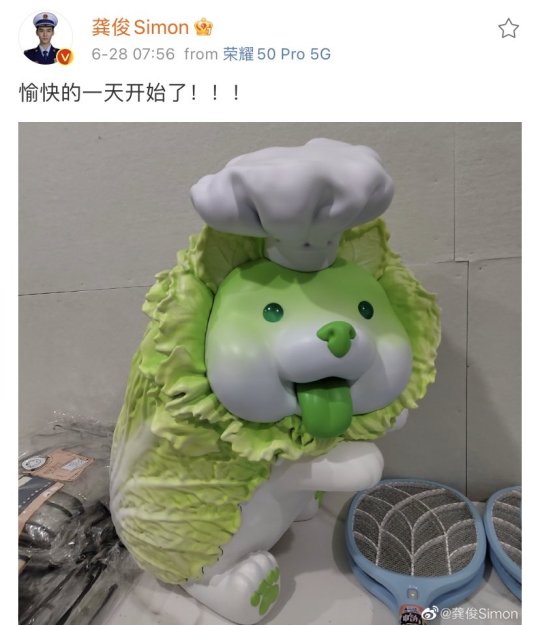
The inspiration for the blue Jun Roll is of course the sunhat from Go Fighting Season 8!
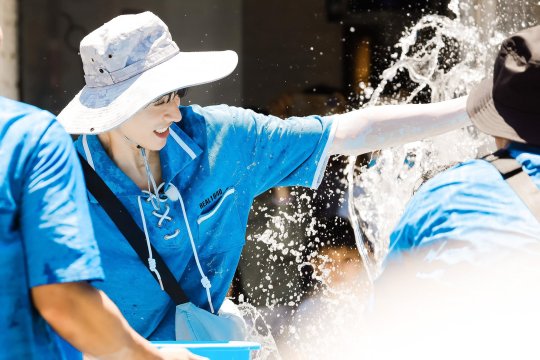
Which is of course my excuse for one of my favorite pictures of him! I love this one.
But maybe a few more pics before we have to dive into the figs...


Ahhh I feel fortified. Ok, let's brace ourselves and get this done, shall we?

So these are clearly resin, because they're snuggly packed in a custom polystyrene box. Normally I pay a little bit extra to bubble wrap resin figs to protect them on the long ocean voyage to the US. For these, well, I decided I'd leave it up to fate if they made it or not.
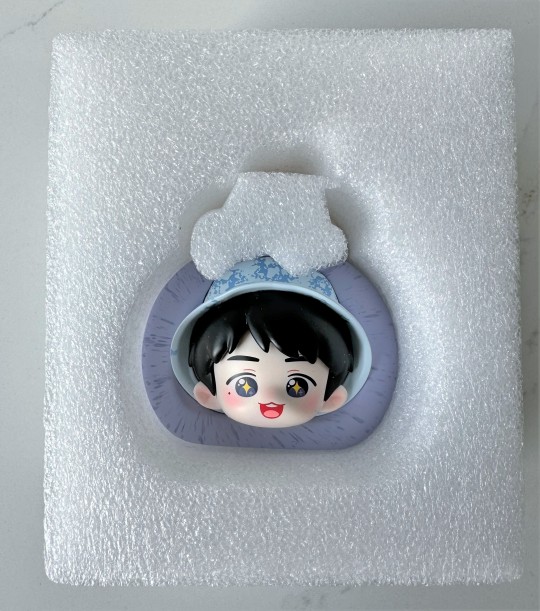
Oh, they made it just fine, gentle reader. And no wonder - they're as solid as bricks. I could probably use this as a self defense weapon. These will probably survive a major natural disaster.

Wow. What the heck. I'm not sure this fig needs any commentary, so I'll just drop the roll of pics here...
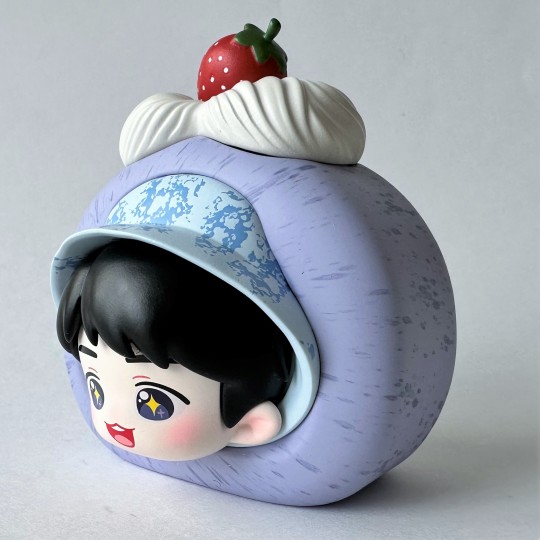
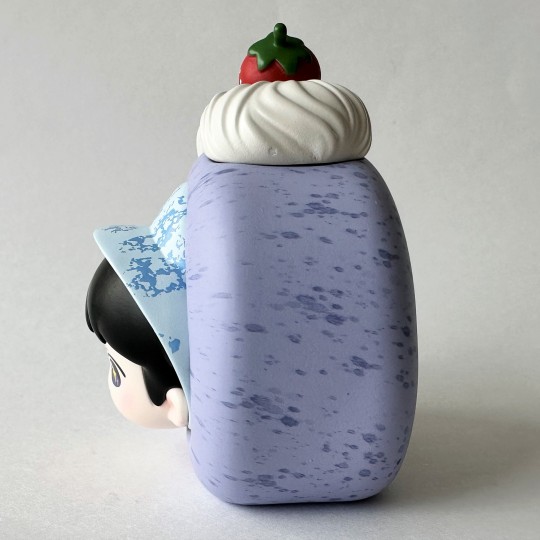
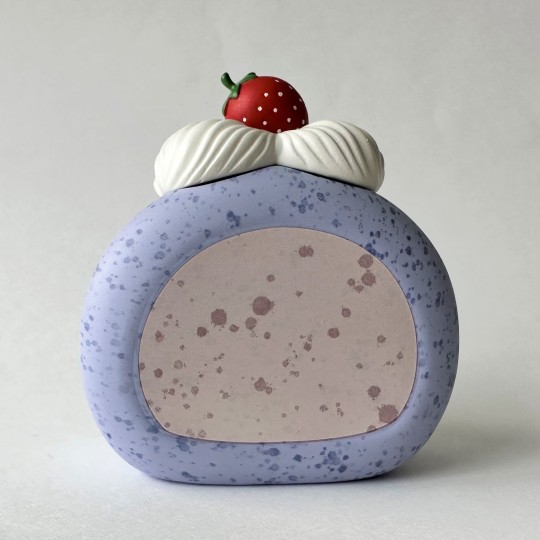
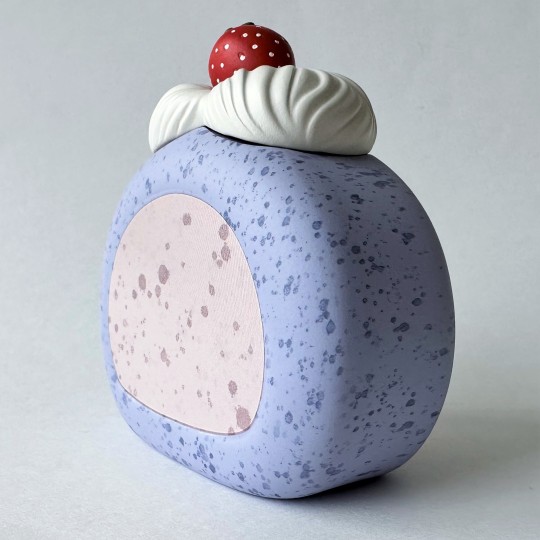

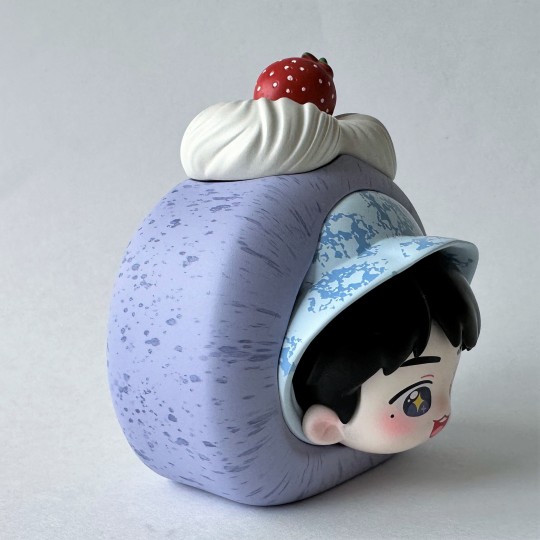
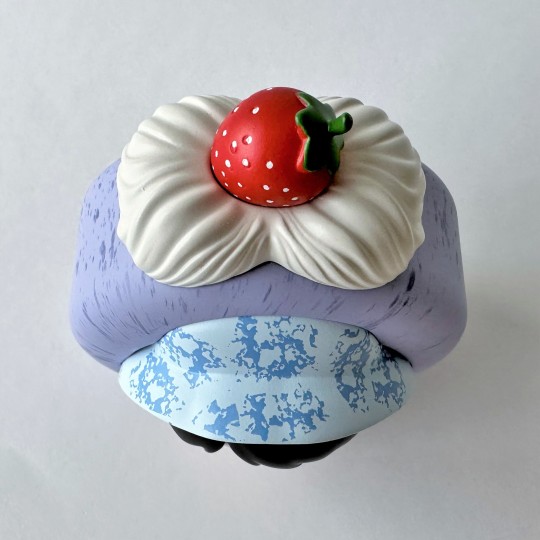
Ok, that's Swiss roll one down. They're not poorly done or anything, they're just...something. I'd say something like, who thinks of this concept?!?! but artists are artists, after all, they're bound to be creative. The more relevant question is, who buys this concept??!
Yep, it's me. I will say I wasn't even drinking when I bought them. I thought, well, if I was ever curious about these or wanted to complete my collection, now is the time since I'm certainly not going to pay Xianyu pricing for them.
I mean, I would take a drink now, that's all I'm saying. But in the meantime, I'm just gonna keep grimly forging ahead.
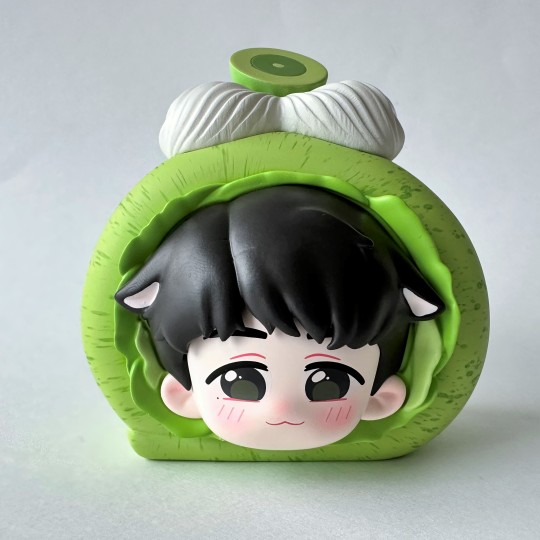



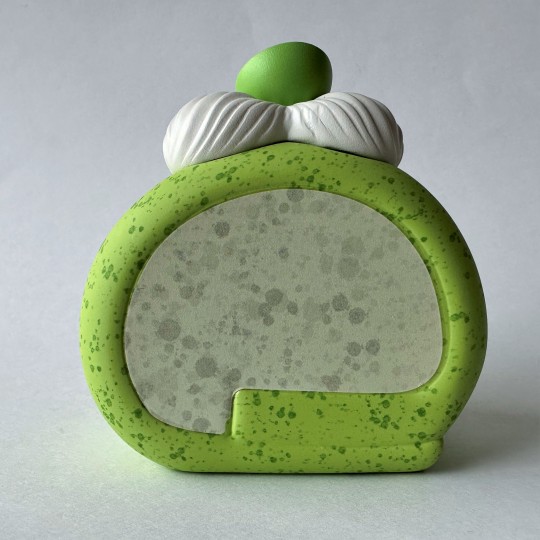
I kind of like that this is actually more swiss-roll like - you can see where the sponge cake is kind of wrapped. It's curious it's not like that on the other one. Maybe the other one is like some other variety of the swiss roll.

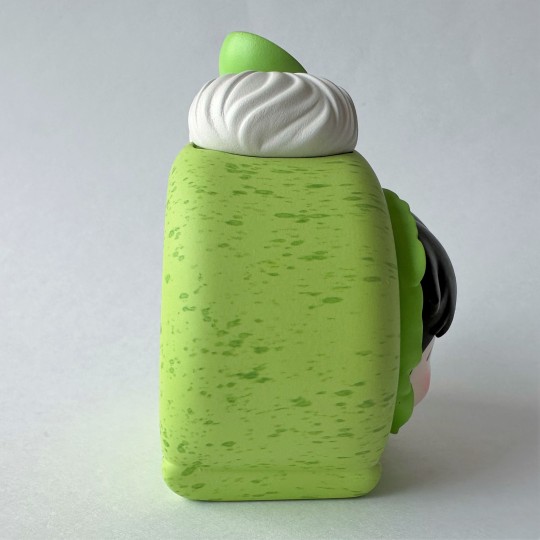

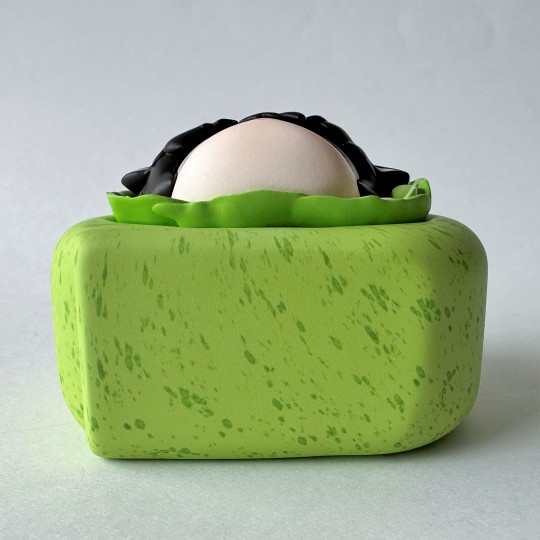
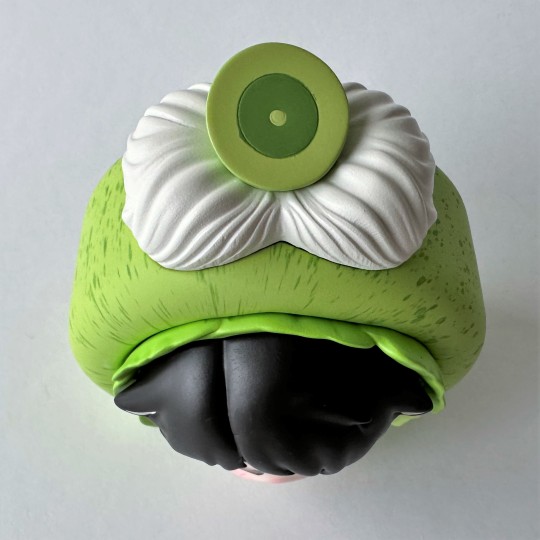
They are immensely heavy and very, very solid. They would make excellent paperweights or even bookends because they're so solid.

For context, here they are with a regular sized fig. The Swiss roll might be the same size in terms of relative height, but the gigantic disembodied face and of course the sheer solid mass makes these feel very big on the shelf up with the rest of the figs.




Yep, these are from the Happy Birthday dessert collection.
Never have I blown through a fig post as fast as this one. No lingering over the figs here!
Material: Resin and some childhood heebie jeebies
Fig Count: 317
Scene Count: 23
Rating: Aiya wo de tian ah
[link back to Master Fig Index for more posts]
7 notes
·
View notes